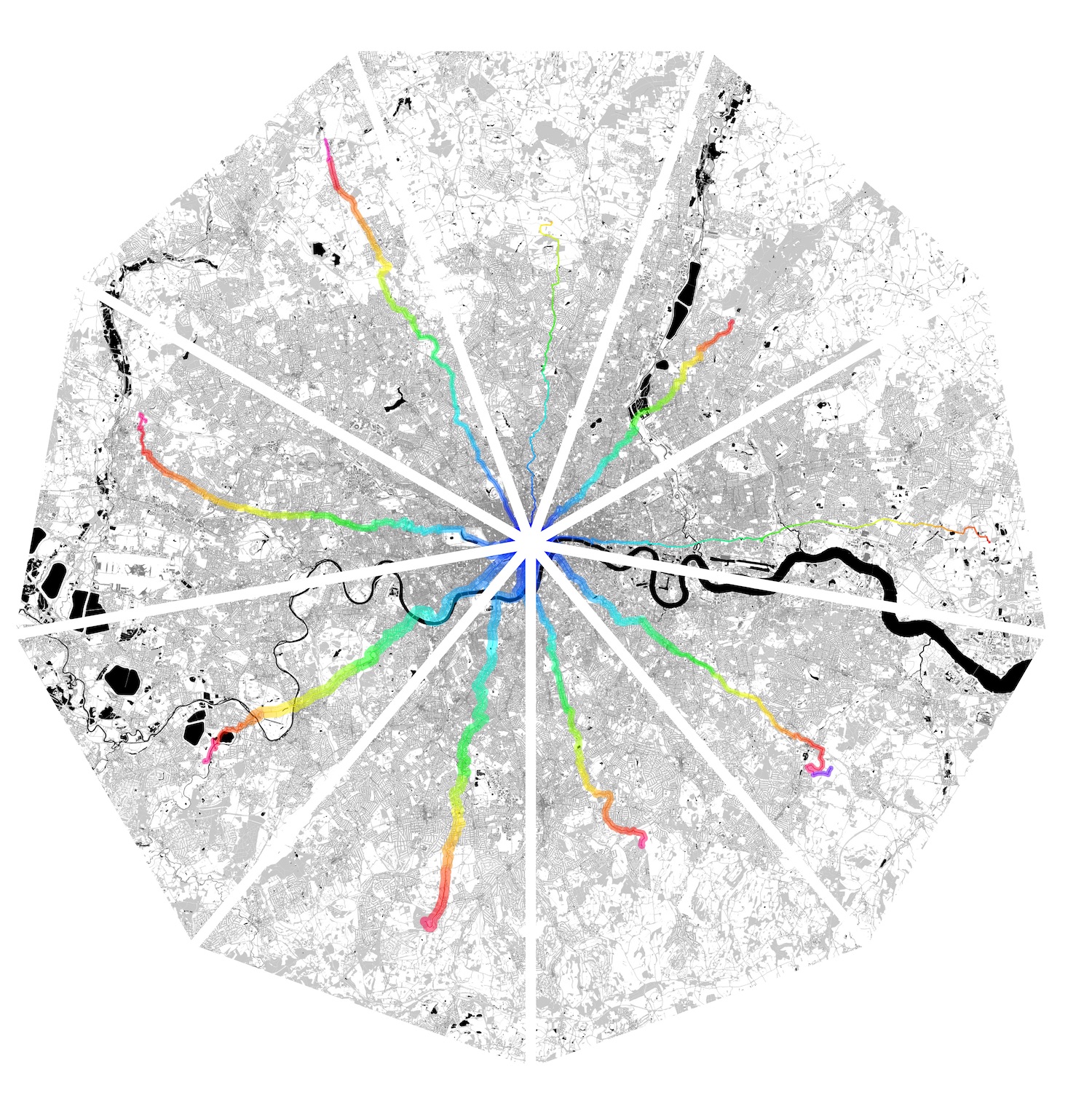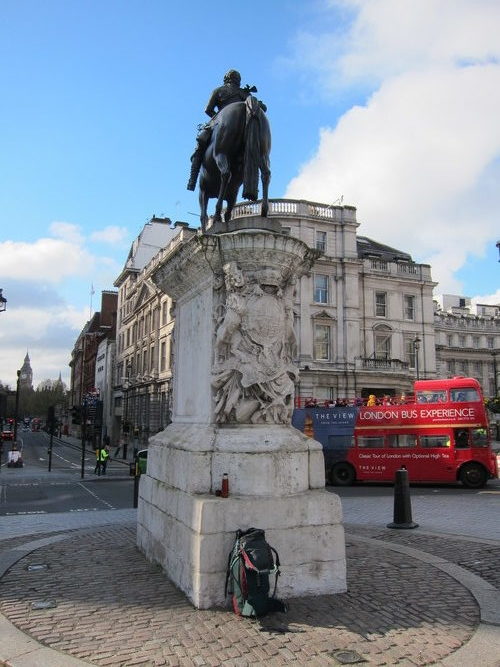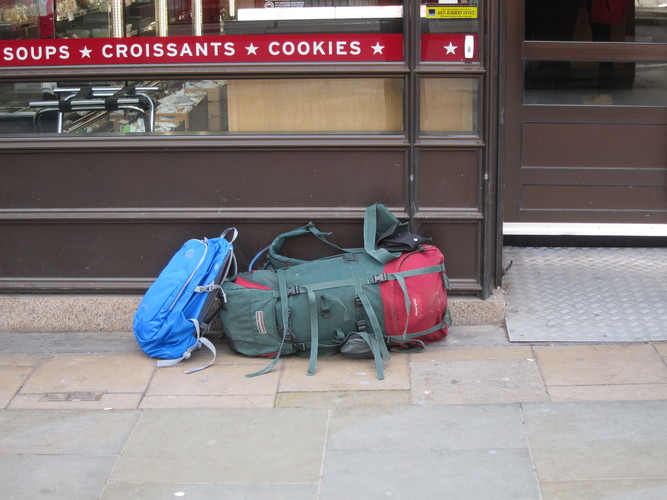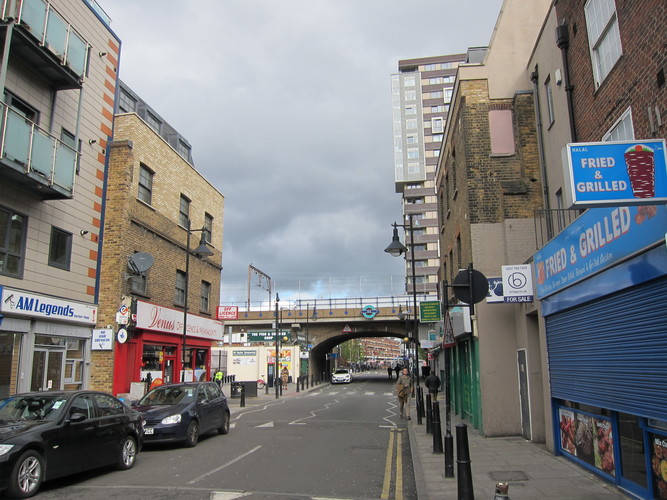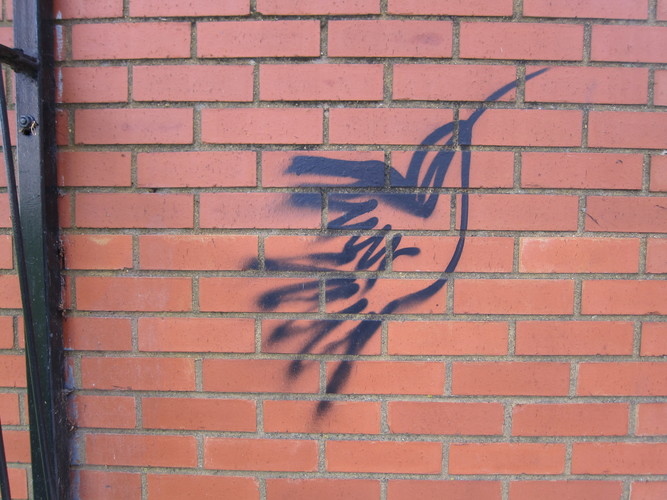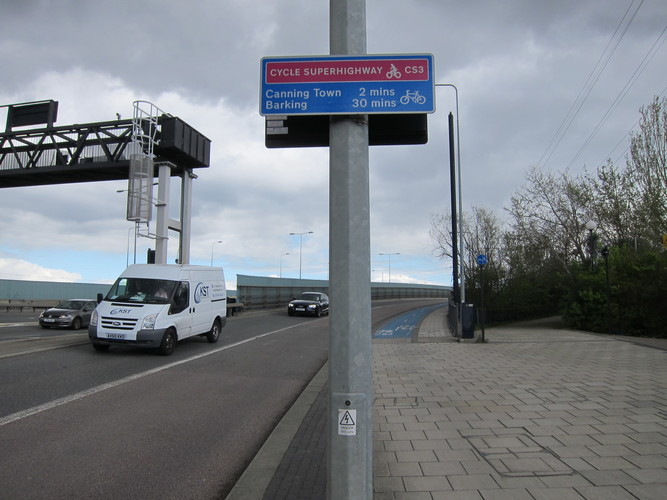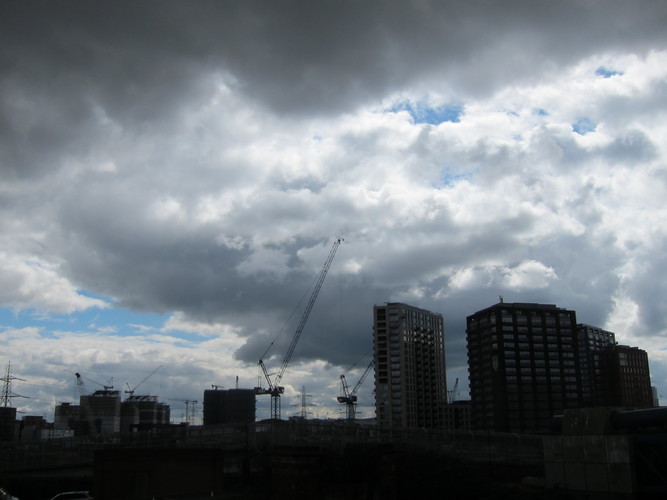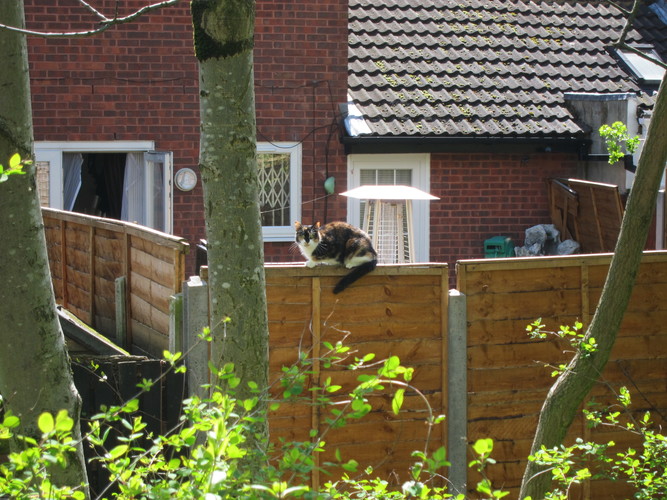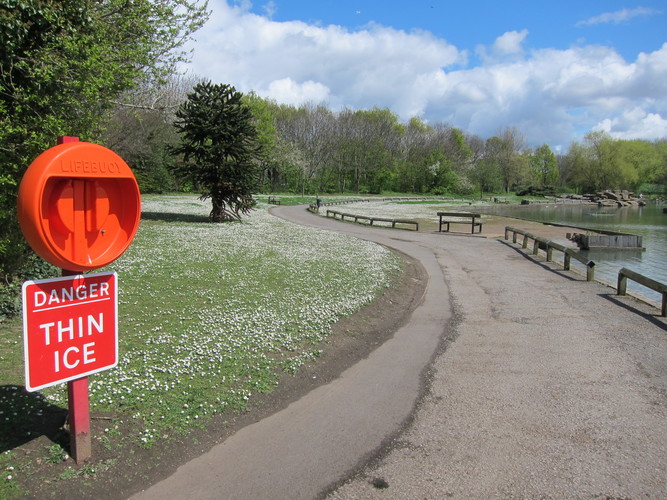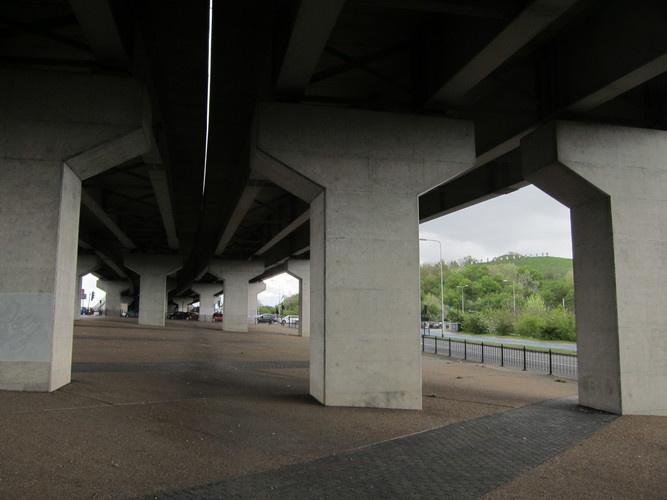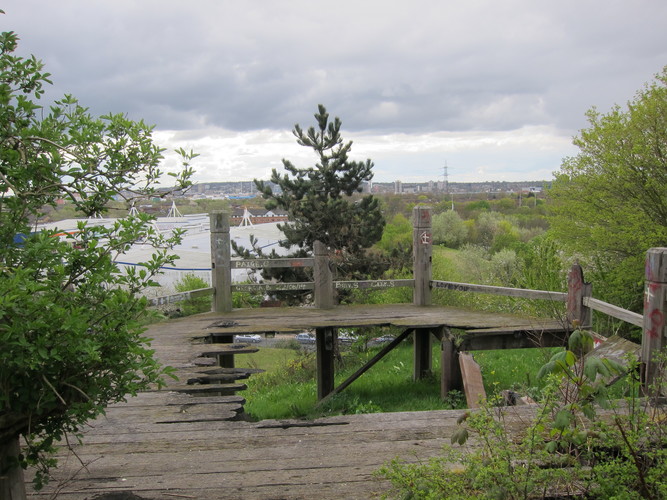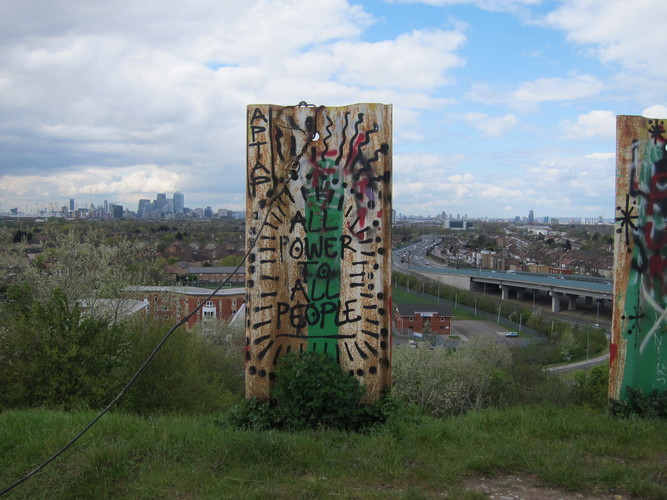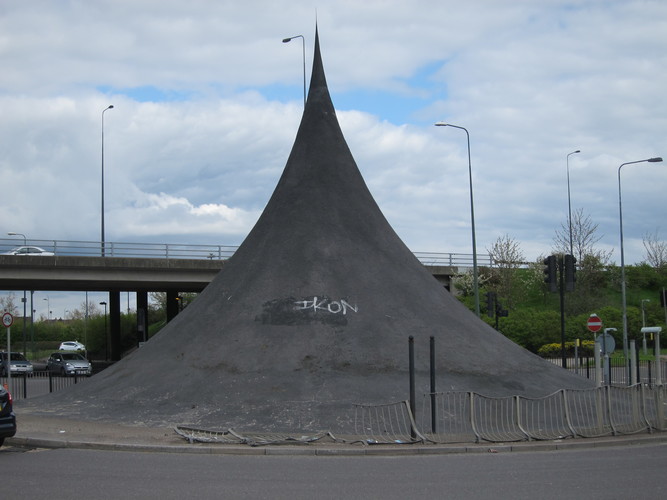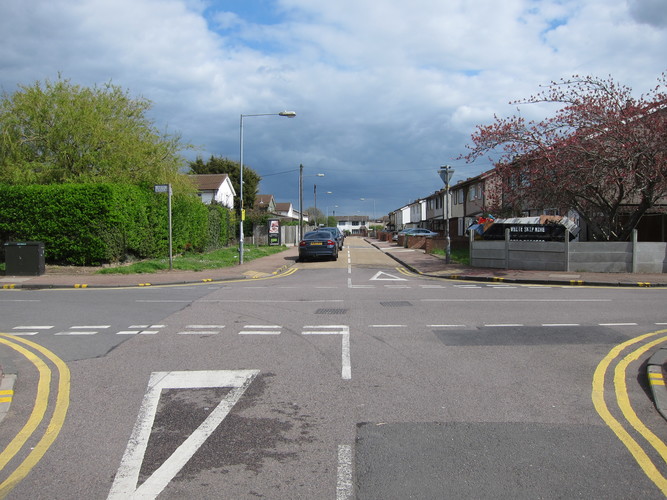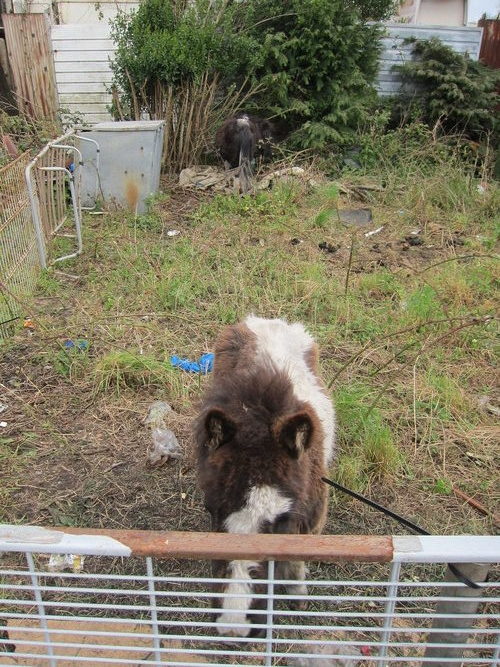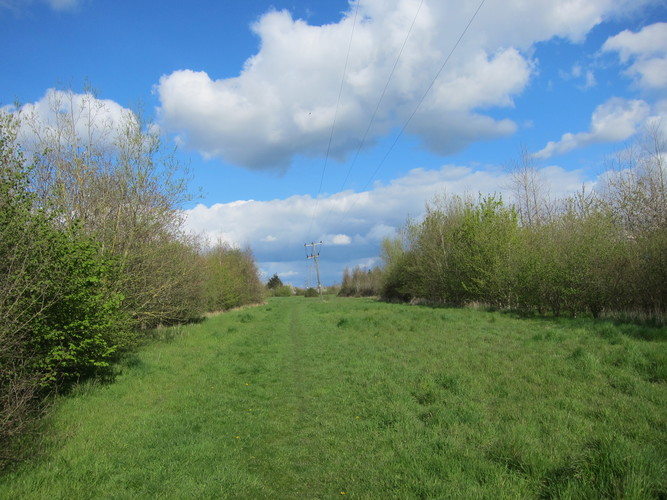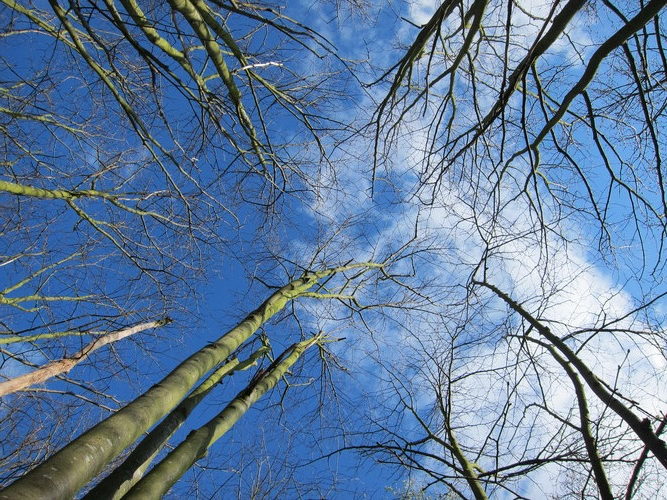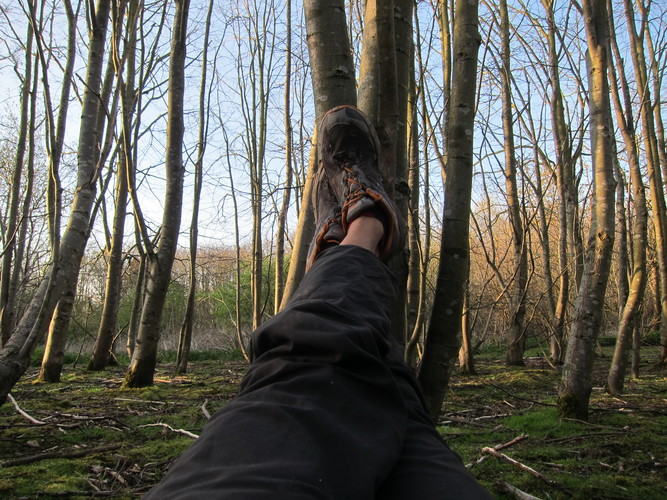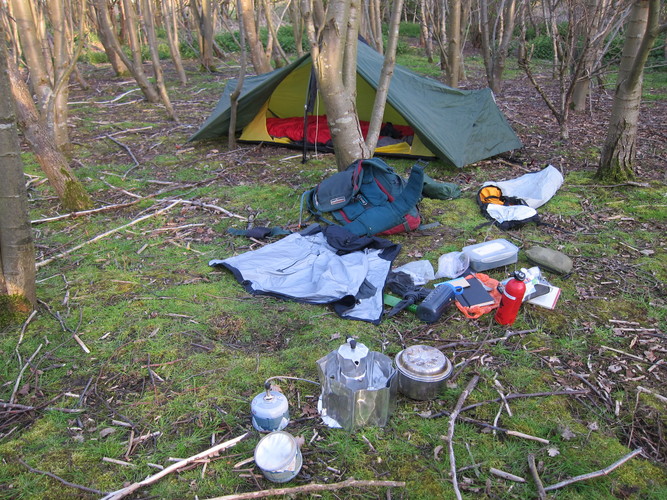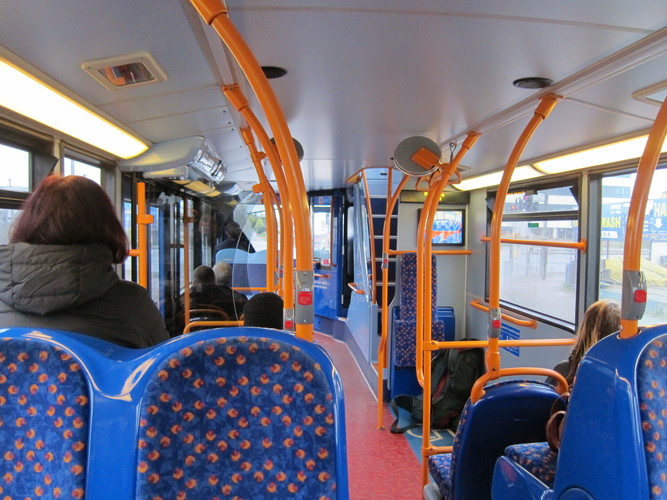I arrived just before 9am. I’d only had five-and-a-half hours sleep, but was feeling good. It was a gorgeous sunny morning, and a joy to walk through the park to get to Charing Cross. I drank coffee, waiting. My watch strap had broken recently so I didn’t have my watch with me, meaning I didn’t have immediate access to the time. I liked that, in a way. It stripped away the grid of hours draped over the day.
Sarah arrived. She’d thought I had meant Charing Cross station. I finished my coffee, and we headed off. Down towards the river and through a few alleyways past ancient pubs. The route this time led parallel to the river for a few miles. The weather was glorious; sparkling hazy sunlight and blue skies. The Shard glittered on the other side of the river.
After following the river for an hour or so we doubled-back in an attempt at finding toilets. We climbed some winding stairs under London Bridge, and slipped into a chain sandwich shop for our toilet break. It was remarkably warm and clean inside; another world. The glorious hazy sunshine continued over the river.
We walked on. An hour later Sarah had to leave; she had a yoga retreat to go to that she was already late for. Alone, I picked up the pace. The direction this time seemed to work well with the texture of the London roads. I was on an expressway out of London, with little friction.
The ‘Yurt Cafe’ craft coffeeshop was one sign of the City giving way to East London. I arrived at an intersection and wasn’t sure which way to go. I opted to walk under a railway bridge, only to be funnelled immediately under another bridge back to the side I’d started on. Pigeons lurked. I moved on, passing Limehouse station, new yellow brick apartments, and emerged onto Commercial Road. It was barren. Over a canal. A marina. I guessed Stepney. A railway bridge. Then Limehouse Town Hall, which looked interesting—an independent arts centre?
Then, across a bridge over a body of water. It didn’t look like a canal. Maybe the River Lea? Clear wide-angle views of Canary Wharf loomed ahead. Big buildings, not human scale. First, though, I passed Trinity Yard Park, complete with ‘Play Here’ sign. There wasn’t much to play with: a few swings, a bouncy see-saw, and it felt sad, though at least green. The part of East London I was passing through was big, grim, functional; a conduit, an umbilical; many apartment blocks, made of brick, yellow and red. I swung back onto the pavement of the A13.
It was the weekend of the London Marathon. There were a few signs of preparation: a guy ran past in a London Marathon top. Training, warming up? I wasn’t sure, it seemed unlikely on the day. Maybe he was just pacing the route. I stopped at the ‘Ideas Store’ in Tower Hamlets for a toilet break, which was much needed. The Ideas Store was a library on steroids. I took my jacket off as it was getting warmer. Next door stood an incongruent English Pie shop, proudly advertising Eel Pie. I ate a homemade ginger and scotch bonnet energy bar. Yum. Good spirits. Two East Londoners yelled at each other from their cars, passing in opposite directions — ‘awight then!’. I picked up my pace again.
It seemed to be my fate to remain on a single main road out of London for the duration. I walked past the Nails and Beauty Lounge. Looking through the window I spotted a clock, and learned that it was 11:30am. I wondered how amazing it was that I was restricted to just this one main road, straight out of London. Big, non-human-scale silver-clad buildings sat to my right. Maybe they were a hospital? I didn’t know. I passed Nutmeg Lane bus stop. Dark, dark clouds hovered to my left, but it was still sunny, and the sky was otherwise blue. I remained optimistic about the weather. Nevertheless, I still had the huge shiny-clad buildings on my right, and Canary Wharf nearby. Olympic Park was north of me, maybe a mile away, I guessed I wouldn’t be going through it. Brooding clouds ahead evoked a Donnie Darko-style solipsistic catastrophe.
I moved into a zone of brutally large arterial roads, heading out of London, inhuman in scale, functional, industrial; almost awe-inspiring. An organisational structure that transcended and forgot humanity. This, accompanied by fresh lashings of cold rain.
A filigree network of cranes and telegraph lines next came into view on the right, tracing the a trajectory toward the river. Layers of construction, with the large, freshly-completed buildings nearer the road, against the dark skies. Large concrete overpasses were accompanied by bicycle highway signs stating, “Barking — 27 minutes”. The road I was following was a portal, together with the bicycle highway. Amazingly the road consistently ran at 80°. It felt lazy to be following such a road but I lacked agency to do anything different. A pedestal clock in a triangle of green tried to convince me that it was midday.
The road’s intent shifted from pedestrians to cars. A man walking ahead of me dropped a can of beer on the pavement. I picked it up and carried it to the next bin. The road went on and on and on, carrying me and the blue bicycle highway out of London. The Plaistow turning was next, with signs for Customs House; Silvertown. And, apparently ahead, Tilbury and Barking, along the A13. A removals truck went by belching white smoke. The sun came out, to my gratitude. My legs were simultaneously warming up, and maybe getting a little tired. I wondered where I’d sleep that night. I had packed Tove Jannson’s Finn Family Moomintroll to read, to which I was looking forward, together with the yoga class the following evening.
Soon, a tall brick wall separated the pavement and the road. Then, the pavement became a tarmac path that cut across a small green triangle. I wasn’t sure if it was the most efficient route, but the compass pushed me in that direction, and it carried me away from the road. Next the path delivered me into a grassy parkland area with an incongruous “Danger Thin Ice” sign by a pond, which I realized was a boating lake. A strange place: a mother pushed a pushchair around the pond; a teenager with his hood up cycled around dejectedly; daisies in the grass and another “Danger Thin Ice” sign; moorhens and geese. It was calm and green—much-needed after the long winter. The meandering path passed back near the road, but when I climbed to the top of a green bank in the direction of the road I found that I was separated from the road by a jagged-topped metal fence, and needed to go on before I could get back to the road. A group of men hung about together on a bench near the boating lake as I left. Cherry blossom, sun, dark clouds.
A smaller path through shrubby green trees took me to an industrial side-street, which in turn led me back to the main road and the bicycle highway. It imagined that I was almost out of London, but I knew I couldn’t be. A sign stated that Barking was 15 minutes by bicycle. I hoped to get to Barking, and that it lived up to its name.
The road continued inexorably onward. It was overcast. A huge wind turbine spun slowly in the distance, reminding me of the Mojave. A good-looking hill stood alone ahead, and I wondered if it would be a nice place for lunch. Soon, I spotted people on top of the hill, indicating that it was possible to get up to the top, and I resolved to make it my lunch spot. Then it began to drizzle. The water smelled nice on the dry concrete, although I would have liked it more if it had been warmer. Onward; a blackbird in the shrubs; a discarded chocolate wrapper. Chocolate would have been great.
The rain grew heavier and I dashed across the road to shelter under a hulking concrete overpass. As I approached, three cars crashed into each-other undramatically, at low-speed. There were no injuries, but I could hear raised voices. I crossed the road away from the scene and on to a ‘Greenway’ that skirted to the left of my lunch hill. I reasoned that I should have been able to get up onto the top of the hill from the path, but after searching for a route I became less sure. I wondered which way—there were signs for Becton DLR station, and the Becton Alps. Maybe the hill was the Becton Alps? Or at the very least, one of the Becton Alps? Either way, I was determined to reach the top for lunch, so headed back the way I had come, back to the overpass, with views back to Canary Wharf and central London, now far into the distance. Again, I could see people at the top of my hill. Meanwhile, the three cars remained stationary under the overpass, the drivers continuing to debate. And then, as I looped around the front of the hill, I found a path in. A zigzag path switchbacked up the front of the hill, a concrete path and plenty of grimy rubbish giving it a really back-alley feel. Near the top I discovered that the ‘summit’ was fenced off with tall spiked metal posts. A sign warned ‘Danger — hazardous site. Trespassers keep out’, which was too tempting, and with two rungs of the metal fencing missing, it was easy to slip through, even with my backpack.
The top yielded panoramic views of the flatness of East London and beyond. Facing south was an old wooden viewing platform, burned, collapsed, broken. Other concrete structures projected from the summit—some sort of foundation. A ski slope? Unfinished? Or burned to the ground? It wasn’t clear, but I appreciated the enigma of its apparent audacity, and was glad the full structure didn’t remain intact to give me an answer. I could see a long wooded hill on the other side of the river, which I decided was the hill due east of Blackheath. Greenwich. North I thought I could see Epping Forest where I was on the previous walk. I could see back down to the accident under the overpass; a police car had now joined the three initial cars. I carelessly wished them not to see me trespassing. Being on top of the Alp I could also see ahead, east, to what I imagined to be green fields and green trees. I returned to the burned wooden platform and chewed my way through a malted raisin loaf for lunch, which I enjoyed thoroughly. Then, I decided I should get a move on. Sirens rang in the distance; again, I idly hoped they weren’t coming for me. Onwards, with a campsite in my mind’s eye, though knowing that it was still many hours away.
I walked back down the switchbacking path. Sadly, the Greenway I’d investigated at first wasn’t heading in the right direction, so I moved, onward, along my old friend, the A13. Soon, I found a brick path running alongside the main road, so took that. There were signs for the M25 on the roads, which gave me hope. I hoped I’d cross it, if not on this walk, then a future one. The main road took me past a large suburban supermarket. The surroundings were all very green, but also scraggly, with plenty of litter everywhere. Then, a horse in a field, surrounded by outer-suburban industry and commercial parks. More light rain. And on, past a household recycling factory, with piles of mattresses inside the building. A bus stop, labelled North Circular Road. Moe’s American-style Diner, deflatingly mediocre, a tired cliché that only ever worked by its context. Landfills of abandoned dreams. Barking, 10 minutes by bike.
The road crossed a wide stretch of water, clearly natural, although I didn’t know what it was. The A13 continued to soldier on at close to 80°. A sign for the M25 on the grassy verge told me, to my dismay, that I still had 11 miles to go. Meanwhile, a learner driver moved slowly down the busy road, patiently accepted by fellow drivers. The clouds had darkened again, and I felt sporadic drops of rain. It sensed that I was getting further and further out of London despite the remaining distance to the M25. I broke off from the road and into an exciting alleyway between scrubland and a wooden wall against the traffic. A small river emerged from the scrub, next to the path. But as soon as it appeared, the path came to a disappointing dead end and I needed to climb back over a railing to return to the road. The railing was nice and new, with fresh London turquoise and lime-green paint.. Today there had been many of these crusty spaces, green spaces with litter strewn over them, close to roads, yet rarely used by walkers. Moving on, I passed a large metal bridge. Retail establishments consisted of plumbing and decorating stores; out-of-town type things, the same old scenery, and my energy lulled, a dip in my excitement. I’d been on this main road for much of the day.
Next, back on the road, I passed a white-painted ghost bike chained to some railings, a nice token of life (well, death) in suburbia. A string of unique venues: the ‘Pick and shovel’ bar; the UKs longest indoor karting track; Sunnys Cafe; the Redeemed Christian Church Of God. A man parked in his car outside Sunnys Cafe looked at his phone, smoking a cigarette. I wondered if this was Barking. Suddenly, a brick wall came between the main road and the pavement, and I was walking past suburban houses instead of a major road. The wall made it much quieter; peace, but I continued to feel deflated. A clock told me it was five minutes past 2pm. Was that really the time?! I had stopped asking whether the road was going in the right direction, and shifted to just passively accepting. And then I was in Dagenham. Dagenham bowling. A striking, inspiring, challenging sculpture, a mathematical singularity, sat opposite a haulage warehouse.
The compass next took me through a supermarket car-park, and pulled me, finally, away from the busy main road. Carcasses of shopping carts lurked in a stream. Then I was back onto side streets, to my relief. I spotted some asymmetric brickwork on top of a row of shops that I thought Tom would have approved of. There weren’t many trees. The area bore a vague semblance of the Yucatan, an odd hybrid of the wild west and pebble-dashed suburbia. Signs for Dagenham East signposted my progress.
Afterward, the road crossed an open park with football pitches and wide-open skies. Three or four people kicked a football around while a guy on a motorbike scooted around over the grass. I thought about finding a campsite and lying on the floor, looking at the sky, but instead took footpath #33 to Wellington Close. The footpath passed an electrical substation surrounded by viscious spiked metal fenceposts, and emptied into an untended strip of grassland in the midst of suburbia, ever-more open and spacious. The grassland was damp, with rushes in the grass. Then, out of sunny suburbia and onto a dual carriageway. An elderly lady, maybe ninety years old, was dropped off by an elderly man. She looked sharp. In the back of the car, flowers. He wasn’t quite as elderly as she was, and I wondered if he was her son.
On, again, past the dual carriageway, and the view continued to open. Horses, fields. I didn’t know exactly what was going on, but I felt on the brink of London. Footpath #246 led past piles of skips, rubbish, and a baby pony, then an unpaved road and a dirty row of houses with the disembodied clucks of unseen chickens. Then, an outdoor centre, a football pitch, and reentry to suburbia, the footpath having vanished.
Despite the teasing glimpse of otherness, however, endless suburbia continued. I entered a cul-de-sac, looping back around, an exhausting exploration of the immensity of the eastern edges of London. I passed Mungo Park road, and pondered whether or not Mungo Park was a colonial explorer of Africa. Unforseeably, I slipped down an innocuous path between suburban homes and into Hornchurch Country park, a promising suggestion of a way into the countryside, starting with a pleasant grassy field. I know it would be necessary to walk through some more fields to find a wood before setting camp, particularly on a Saturday night. After 10 minutes of walking I emerged at a pleasant grassy clearing with some picnic benches and stopped for teatime. Teatime was much needed, and I stretched and ate, finishing off the malted raisin loaf I’d started for lunch. Peanuts and raisins were welcome supplement. I felt I was finally out of London, though I knew it wasn’t true countryside yet, more just groomed outer-city parkland. On the distant horizon, maybe two miles away, I could see what looked like proper English woods. I hoped that in the next half an hour or hour I would be able to walk into some of those woods, and setup camp.
I walked onwards through the parkland, beginning to trudge. I crossed the London Loop, which I remembered I had walked along just before I finished the first walk. Nevertheless, the track I had been following dumped me out of the country park and onto a main road. It wasn’t clear whether the footpath continued the other side of the road, and I arbitrarily chose a direction, walking a miserable quarter-mile along the busy road with no pavement until I reached the quaintly-named Little Gurpins Lane, which I took. A London black cab drove past, the cab full of timber. My morale was increasingly low. I wasn’t at all sure when I’d be able to pitch camp, and I felt lost wandering these lanes without paths or woods. I left the lane and walked through a plantation wood. Very new, small trees, so not good material for sleeping. I wouldn’t be terribly comfortable here, so I kept on, heading further and further away from London. I reassured myself that this time was likely no worse than the first walk. I left the plantation and walked along a busy main country road, a walk that felt pointless. A promising looking wood on the left was a paintballing area. I continued along the road feeling sorry for myself.
Eventually I found a footpath on the left of the road, albeit with ‘Private property’ signs. I took it anyway. Aimless and lost, I was cheered as the weather improved as the evening came on. Far, far off into the distance behind me, over the fields, I could make out Canary Wharf, back in London, softly through the haze.
The footpath emerged onto a track, which in turn emerged onto another road. The type of winding country road on which people drive fast. On the other side of the road, however, was an overgrown footpath. I pushed though and, finally, found a wood. It wasn’t great, it was right next to the a road, near a house, and the adjacent field had horses which were free to wander into the wood. The wood itself was scruffy—scrubby small trees and brambles. On the positive side, however, there was no sign that anyone ever came into the wood, and I decided that it was going to be the best I could do. I didn’t think the horses would come in, and broken fencing around the wood would at least slow or discourage them. At least, I really hoped they wouldn’t get through to me. The last thing I wanted was horses snuffling around my tent and waking me up while I was sleeping. I decided that I just had to risk it, but didn’t setup my tent immediately; I’d sit down, first, have a few snacks, read a bit, and maybe do a bit of writing. If things still seemed well, I’ll setup my tent and settle in.
I read my book. I wrote. I lay and looked at the sky. I setup my tent. I made lentils. Peace. The lentils were great. The sun set slowly, although I couldn’t see it because of the wood. It was nice to sit and watch the sky, and I was exhausted. I clambered into my sleeping bag, but slept poorly in the cold. The magic of the pristine wood of the first walk was absent, as were the wheeling owls of the second.
I was up and gone by 6am. It was freezing as I packed up. It rained, then hailed, and my fingers were numb. I walked back the way I’d come, down the miserably busy main road, thankfully less busy in the early morning. I had fantasized turning a corner to find a sign saying ‘Welcome to London’. But it doesn’t work that way. I passed farm shops, selling coal, fresh honey. I stopped in Bonnets Wood to turn off my faint alarm. I reckoned that it was still a long way to London, and further again to Dagenham East station, so increased my pace, flushing flashing white rabbit tails into the hedges. Many of the trees were still without green. It was remarkable how many trees where I had camped still had no leaves; it felt wintry.
Passing a Water Vole Sanctuary, I ascended to a slight rise to a view of the London skyline faintly through the mist. Then back onto the road, and I realized that I was close to the country park through which I had left London. And, indeed, the gates into the park were just around the corner. It felt good to be in my body, with deep breaths and sore hips. Onward, back the way I’d come, back through Berwick Woods, past a man with a dog and a tennis ball thrower. Chirping birds. A concrete pillbox. Wet grass and wet feet. But soon suburbia was just there, behind fences, almost within reach. And so soon I was back on track, re-entering London via the Northwestern Passage of the discrete alleyway, re-entering wet and grey suburbia. Mungo Park road remained as mundane as it had been the previous day. I caught an opportune bus to Rainham supermarket, found a train station, but no trains were running, and a local transport map revealed that there were no tube stations anywhere nearby except Barking. So, feeling my way, I caught a second bus towards Barking. The bus picked up Eastern Europeans with large suitcases on the way, and passed ‘Yogi newsagents’. Excellent. It was almost 8am by the time I finally reached Barking Station and set sail for home by railway and tube.
